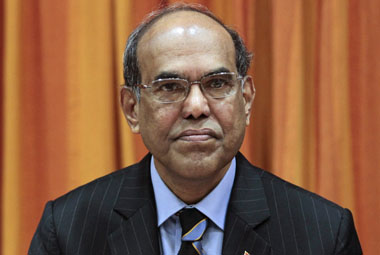By R Jagannathan
Reserve Bank Governor Duvvuri Subbarao does not lack for issues to take the finance ministry head on.
He has strenuously opposed the ministry efforts to get interest rates down without a commitment to get the fiscal deficit under control and without significant easing in inflation rates. So far, he has managed to hold his own in this battle.
He has opposed the ministry’s efforts to set up its own debt management office (DMO) instead of letting the RBI manage the government’s borrowing, but so far the ministry has looked like winning. Earlier this year, there was talk of bringing in legislation for creating a DMO, but in all the political confusion after the bruising battles with Mamata Banerjee, the bill has been forgotten. Now that Pranab-da is headed for Rashtrapati Bhavan, who knows Subbarao may get a second hearing on the DMO.
[caption id=“attachment_377061” align=“alignleft” width=“380”]  Governor Duvvuri Subbarao attends the monetary policy review meeting in Mumbai") Reserve Bank of India (RBI) Governor Duvvuri Subbarao does not lack for issues to take the finance ministry head on.[/caption]
He had opposed the finance minister’s bid to head the Financial Stability and Development Council, but Pranab Mukherjee prevailed. Subbarao saw that as an encroachment on the RBI’s autonomy.
Now he has opened up two more fronts in his battle with the finance ministry.
First, he has raised corporate governance issues with the ministry for issuing orders to public sector banks directly, by bypassing the bank boards. The recent directive to banks to avoid bulk deposits beyond 10 percent is a case in point.
At a recent function in Mumbai, Subbarao said: “There are questions about how the government will play out its ownership role. Occasionally, there are concerns over the government exercising its ownership rights not through the established channel, which is the board mechanism, but outside of the board. I don’t think it is a good example of good corporate governance,” Business Standard quoted him as saying.
In short, Subbarao is saying the finance ministry is setting a bad precedent for governance.
Second, he has raised questions about the politically-driven approach to agricultural credit, which has risen faster than overall bank credit. During UPA-1 and UPA-2 till now, agricultural credit has risen more than five-fold from Rs 1,05,000 crore in 2004-05 to Rs 5,75,000 crore (estimated) in 2012-13. But Subbarao wonders if all this money is going to the right people, especially since agricultural loans are subsidised.
He said: “On visiting some states’ bank branches, it was not clear that the credit being shown as lent to farmers was actually used for agriculture purposes. This evidently defeats the objective of the subvention scheme (for farmers) and needs to be corrected either by modifying the subvention scheme or through tighter monitoring of the end use of agricultural loans.”
Subbarao would like the subsidy either withdrawn or rationed through better monitoring. He also said that the rapid expansion in agricultural credit was increasing bad loans for banks, reports BusinessLine.
Non-performing loans to the agricultural sector have risen 47 percent in 2011-12 compared to 40 percent for other loans.
To be sure, Subbarao is not saying agricultural loans are a dead loss, since every Re 1 in credit to agriculture results in a 22 paise increase in agri-GDP after one year. But it does mean that our farmers are now getting more and more hooked on to credit to raise output - with rising risks all around for banks. With a bad monsoon round the corner, this is a red flag.
Of course, given the politicians’ love for the farmer, Subbarao is not going to win this battle on agricultural credit. But, clearly, he is preparing to use the remaining 14 months left in his tenure (which ends in September 2013) to highlight all the areas where he thinks the government is messing up.
More power to his elbow.


)
)
)
)
)
)
)
)
)



